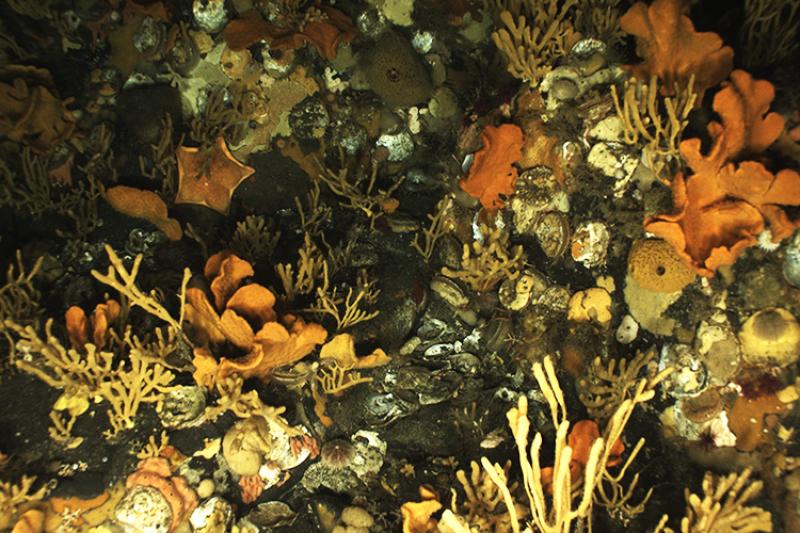Alaska deep-sea coral and sponge communities provide habitat for many important commercial fish. However, these communities are vulnerable to damage from commercial fishing gear. To protect this valuable living habitat, some areas throughout the Aleutian Islands were closed to commercial bottom trawling beginning in 2005.
This summer, an international team of scientists set out to evaluate the effectiveness of these protections at maintaining healthy coral and sponge communities. During two expeditions in Alaska’s Aleutian Islands and Gulf of Alaska, the team used advanced sampling technologies including:
- Stereo camera system
- Autonomous reef monitoring structures
- Remotely operated vehicle
- Environmental DNA
Data collected will be analyzed to compare coral and sponge communities within and outside of protected areas, and to learn how they recover in areas that have been disturbed. The research was a collaborative effort by NOAA Fisheries, the University of Gothenburg, the U.S. Army Corps of Engineers, Fisheries and Oceans Canada, and the Alaska Department of Fish and Game.
The results will be combined with commercial fishing data and literature studies to obtain the first estimate of sustainable bycatch rates for corals in the Aleutian Islands. The work done this field season will contribute critical information to a 5-year Alaska Deep-Sea Coral and Sponge Initiative to inform management of these valuable habitats.
“We’re seeking to better understand if the areas we are protecting are the most appropriate,” said Christina Conrath, NOAA Fisheries Alaska Fisheries Science Center, who co-led the field research with Pam Goddard, NOAA Fisheries affiliate at the Alaska Fisheries Science Center.
Are Existing Protections Effectively Maintaining Healthy Coral and Sponge Communities?
Alaska’s Aleutian Islands are home to more than 95 coral and 135 sponge species. Many commercially important fish, such as Pacific Ocean perch, golden king crab, and Atka mackerel, are associated with coral and sponge communities.
In 2005, in response to concerns about the vulnerability of coral and sponge communities to bottom trawling, NOAA Fisheries and the North Pacific Fishery Management Council closed areas throughout the Aleutian Islands to this gear. These closures effectively allowed existing bottom trawl fisheries to fish where they always had, while protecting the rest. Some additional areas identified as “coral gardens”—particularly rich and diverse coral and sponge communities—were also closed to all bottom gear fishing.
The Council has recently identified evaluating the effectiveness of fishing closures as an important research priority.
This summer, researchers collected critical data to answer two fundamental questions to inform management of Aleutian Islands deep-sea coral and sponge habitat:
- Are existing fishing gear closures effectively maintaining healthy coral and sponge communities?
- Have coral and sponge communities within closed areas recovered from previous fishing activity?
Advanced Sampling Technologies Shed New Light on a Hidden Realm
The team deployed an array of innovative tools to collect the data needed to answer these questions. These innovations made it possible to collect previously inaccessible information from cold, deep, dark and remote coral and sponge habitat. During July and August 2023 expeditions, the team surveyed coral and sponge habitat using a stereo camera system. This cost-effective, highly mobile technology allows precise measurements of the size and height of corals and sponges by region, depth, and habitat type. They sampled areas that were unprotected, protected since 2003 or 2005, or protected then reopened in 2015.
“The camera system has been a breakthrough in working in these habitats,” Goddard said. “We couldn’t do this work without it.”
They recovered an autonomous reef monitoring structure deployed the previous summer. A variety of larvae can settle on these stacked plates, providing valuable information about coral and sponge recruitment and biodiversity in the area.
They sampled eDNA for biodiversity and other genetic studies. Meredith Everett at the NOAA Fisheries Northwest Fisheries Science Center will analyze these samples to identify DNA shed into seawater by multiple organisms in different areas.
The team attempted to collect live red tree coral sprigs for laboratory spawning experiments. Due to technical issues, they could not collect the sprigs and the experiments will be postponed until 2024. Coral reproduction experts Rhian Waller and Lara Beckmann, University of Gothenburg, Sweden, will conduct these experiments at the Alaska Fisheries Science Center Auke Bay Laboratories. This work will be the first to document reproduction and larval development in this important species.
Providing the Science to Balance Protection and Productivity for Sustainable Fisheries
Findings from the study will inform management decisions regarding sustainability of current closures and potential future changes in fisheries.
Specifically, the project will:
- Compare density, size structure, and damage to coral and sponge among closed, recently opened, and continuously fished areas
- Compare patterns of commercial fishing effort from vessel monitoring system data collected since 2003 with seafloor features such as ruggedness, slope, and depth, which will help to determine the seafloor characteristics that are associated with fishing.
- Combine results with growth rates from the literature to estimate sustainable harvest rates for corals in the Aleutian Islands
“With the combined results of this research, we will be able to tease out the intersection between coral habitat and fishing to help evaluate and predict the effectiveness of recent and future management actions,” Conrath said.
John Olson helped design the 2005 habitat protections with the NOAA Fisheries Alaska Regional Office. He is now a partner in the new research with the U.S. Army Corps of Engineers.
"When the North Pacific Fisheries Management Council and NOAA Fisheries were developing the protected areas in the early 2000s, we didn’t have the precise data on where fishing occurs that we do today. The fishing fleet tended to fish similar spots, so freezing the footprint of mobile bottom contact fishing was effective for the purposes of the management measure,” Olson said. “As changing ocean and climate conditions impact fisheries, additional habitats may need to be assessed.”







